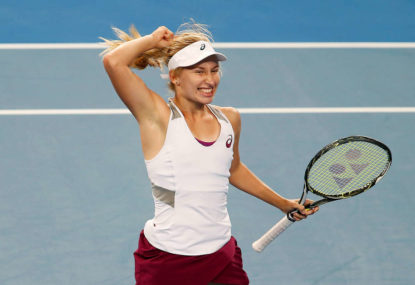Demon slays the King: de Minaur savours 'once in a lifetime' moment after knocking off Nadal on clay
Rafael Nadal has hailed the brilliance of Alex de Minaur, calling him "a great player" after the Australian forced the Spanish legend to say…

As the 2016 Australian Open rolls into the second week in Melbourne, Tennis Australia have a very wealthy reason to be happy coming towards the finals of their marquee tournament and the new year.
Coming off the back of a host of new sponsorship deals with the likes of Emirates, McDonald’s, Canadian Club and even Disney; Tennis Australia’s sponsorship revenue has increased nearly 50 per cent to $66.2 million at the end of the 2014-15 financial year.
According to Tennis Australia’s financial report released in November, for the aforementioned financial year, sponsorship now makes up for over a quarter (26%) of their mammoth $254.59 million total revenue. It is only just edged out by media rights (31%).
Competing with so many major sporting codes within Australia such as AFL, NRL, Super Rugby and cricket, tennis in the land down under has always had to fight for relevance and revenue.
Despite playing host to multiple tournaments, events and programs, tennis in Australia is often seen as a just couple of weeks in Melbourne at the start of every year.
Compare this to an entire season of AFL or NRL that play around 30 weeks of content for the fans, television contracts and advertisers to lap up.
So it comes as no surprise to see the importance in which Tennis Australia places on its sponsorship deals.
Having neither the merchandising power or ticketing revenue to match the elongated seasons of the team-based sports, Tennis Australia has simply been forced to make its money away from replica team jumpers at merchandise tents, and the ticketing prices of 40,000-seat stadiums.
Raking in $66.2 million dollars solely through sponsorship has jumped Tennis Australia to the top of the Australian sporting mountain – the Australian sporting sponsorship mountain anyway.
Their closest rivals are the AFL and Cricket Australia who garner roughly $50 million a year. Whereas the NRL, Football Federation Australia (FFA) and Australian Rugby Union (ARU) generate about $30 million.
Despite the seasonal length difference between the various sports, tennis is really the only one of the Australian sporting codes to boast a truly international event that brings exposure from all corners of the globe.
Regardless of the fact events like the NRL and AFL grand finals attract huge domestic exposure, attendance and revenue, the Australian Open’s ability to obtain such a vast international audience leaves their opponents in the dust.
Without the broadcasting rights of a six-month season to lean on, Tennis Australia still miraculously outshines their competition financially through their sustained marketing, particularly throughout Asia, creating a global market to fund their constant expansion.
Following an Australian Open win for China’s Li Na, as well as some strong showings from Japanese hero Kei Nishikori, Tennis Australia has seen huge surges in viewership, merchandise and popularity within the two major Asian nations and throughout the south-east of the continent.
So much so that, despite being initially titled the Australasian Championships in 1905, the annual Australian Open tournament has been heavily marketed in the past decade as the ‘Grand Slam of the Asia-Pacific’.
Placing importance on their northern neighbours’ contribution to the tournament, Tennis Australia has made sure to open as many doors as possible into the Asian market. Including the recent opening of a Hong Kong office to cover their Asian media, sponsorship and marketing aspects from the ground.
Beginning last year at the 2015 Australian Open, Tennis Australia orchestrated a revised broadcasting deal that saw them televise and record all 411 matches from the main draw.
This ventured away from the traditional broadcasting rights of televising main court matches and local players. The new deals have seen huge surges in online media content and viewership of content, particularly throughout Japan, China and, to a lesser extent, Malaysia and Indonesia.
Since Li Na’s retirement in 2014, the Chinese audience has struggled to find a prominent player on the main courts in all Grand Slams, however, the new broadcasting strategy has allowed the Asian public to see their local heroes play on the outside courts at different times and on demand through replay.
Although Tennis Australia’s roaring sponsorship trade throughout Asia and domestically had seen them surge into the future with economic success, their ailing revenue in other areas of their finances are keeping them behind Australia’s other major sporting codes.
Tennis Australia is a long way behind in annual revenue numbers for broadcast rights and merchandise, which again stems from tennis’ short season.
Possibilities to create new tournaments, extending the short season, and really upgrade their production of brand name merchandising – Thoughts for Sports’ journalist Julian Clarkstone has previously discussed improving the merchandising of Davis Cup paraphernalia – could hand tennis the opportunity to expand their income and flood as much money as possible into building their sport.
Of course the more exposure for tennis in Australia, the more attraction from sponsors, advertisers and media outlets.
The more sponsorship, the more revenue and the greater ability to grow the sport within Australia from the grassroots up.